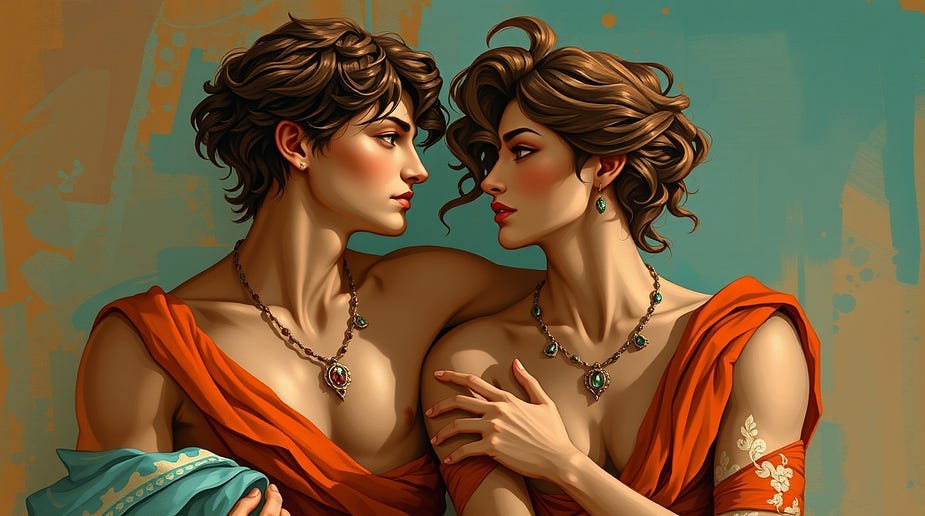Gen Z, Pansexuality, and Anime: The Quest for Unity Beyond Gender
History’s gender warriors: From Castrati to Cosplay
In my 2024 article “The Dawn of Pansexuality: How Gen Z is Redefining Love,” I explored how Generation Z is reshaping our understanding of sexuality and gender, with nearly a quarter of young people now identifying beyond traditional binaries.
The research revealed a striking pattern: from ancient cultures to the modern day, humanity has consistently sought ways to transcend rigid gender categorizations. This exploration led me to discover an unexpected historical parallel in Dominique Fernandez’s novel “Porporino o i misteri di Napoli” [“Porporino or the Secrets of Naples”] (Leonardo Editore, 1992).
Set in the vibrant streets of 18th-century Naples, this historical novel explores the phenomenon of castrati singers as symbols of gender non-duality. While the conversations and philosophical musings Fernandez attributes to the Prince of Sansevero are fictional constructs that I plan to verify in future research, the Prince himself was very much real — and what a remarkable figure he was.
Raimondo di Sangro, the Prince of Sansevero (1710–1771), was one of the most fascinating figures in 18th-century Naples. A nobleman, inventor, and scientist, he established a laboratory in his palazzo where he conducted groundbreaking experiments. Among his most notable inventions was a waterproof cape, but he was also known for creating an eternal flame using chemical compounds and developing a new type of cannon. The Museo Cappella Sansevero, which he redesigned, remains one of Naples' most beautiful and evocative monuments, housing the renowned "Veiled Christ" sculpture. His scientific research, sometimes bordering on the esoteric, earned him both admiration and suspicion from his contemporaries.

The Prince
The Prince’s words in “Porporino” cut to the heart of this rebellion against biological determinism:
“Cosa c’è di più orrendo, di più avvilente e deprimente del pensiero che siamo prigionieri delle leggi naturali della procreazione? […] Perché anche noi non possiamo essere l’origine di noi stessi?”
[What could be more horrifying, more demeaning and depressing than the thought that we are prisoners of natural laws of procreation? […] Why can’t we be our origin?]
The castrati’s hybrid, superhuman voices embodied this aspiration to unite opposites. Even the young Mozart praised their unique ability to fuse “virile virtue” with “feminine sonority.” This quest for unity wasn’t unprecedented — Fernandez traces it back to ancient Greek rituals where gender transcendence was celebrated through transgressive practices.
In ancient Greece, gender transformation rituals permeated many sacred ceremonies. During the Ekdysia, a Cretan festival dedicated to Leto, brides and grooms exchanged clothing, symbolically abolishing the differences between sexes. This practice found its echo in Dionysian cults, where men and women freely adopted attributes of the opposite gender, following the example of their god Dionysus, a divine figure celebrated for his androgynous nature.
Ritual fluidity
The culmination of this ritual fluidity manifested in wedding ceremonies, where the bride underwent a symbolic transformation: her hair was shaved to resemble the appearance of a young ephebe, and she wore male garments. These gestures were not mere traditions but represented a moment of sacred ambiguity, a fluid threshold to cross before assuming the adult roles defined by society.
This eternal human quest finds surprising echoes in contemporary Japanese animation. Fernandez captures this recurring yearning in a passage that perfectly describes modern anime’s treatment of gender:
“La nostalgia dell’eden primordiale, dove tutto è nel tutto e tutto comunica con il tutto e il maschile con il femminile senza distinzione di sessi ne di persone, rinasce così di secolo in secolo con altre sostanze inventate per ogni nuova civiltà”
[The nostalgia for primordial Eden, where everything exists within everything else and all communicates with all, where masculine and feminine flow without distinction of sex or person, is reborn century after century through new substances invented by each civilization]
Anime series
In Anime series like “Land of the Lustrous” and “Revolutionary Girl Utena,” we see modern expressions of the same philosophical quest that fascinated the Prince of Sansevero. “Land of the Lustrous” presents a post-human world where crystalline beings exist beyond biological sex, their gemstone bodies reflecting light in ways that transcend binary categories. These characters navigate identity and consciousness without gender constraints, radically reimagining human potential. Their forms can break and be reborn, suggesting identity as fluid and reconstructable rather than fixed and binary.
“Revolutionary Girl Utena” delves even deeper, with its protagonist Utena transforming between prince and princess roles while exploring themes of gender performance and sexual identity. The series’ famous duelling scenes, where characters transform into swords, suggest that true power lies not in conforming to gender roles but in transcending them entirely. Through its surreal imagery and complex symbolism, the series argues that the binary gender system itself is a form of social imprisonment.
Contemporary Resonance
In my previous article “The Dawn of Pansexuality: How Gen Z is Redefining Love,” I documented these monumental shifts in perception. A 2022 YouGov poll found that 12% of British youth ages 18–24 identify as pansexual, attracted to people regardless of gender or biological sex, with another 10% identifying as bisexual. Similar changes emerge across Europe. In Italy, 14% of Generation Z report being pansexual, with another 9% bisexual. A 2023 GLAAD study confirms that 18% of Americans ages 18–34 now identify as LGBTQ. Of those, 9% claimed pansexuality, 7% bisexuality and 4% as transgender or gender nonconforming.
These statistics aren’t just numbers — they’re manifestations of what Fernandez identified as humanity’s recurring dream of unity beyond division. Generation Z boldly acknowledges that attraction stems from personality, insight, shared dreams and emotional intimacy. Yet as the Prince’s statues crumble, Fernandez warns:
“Ogni utopia porta cicatrici” [“Every utopia bears scars”].
The castrati’s beauty hid brutality; their transcendence required violence. Similarly, today’s gender revolution unfolds amid backlash — from restrictive laws to cultural resistance.
Gen Z knows this. They navigate fluidity while fighting for healthcare, pronouns, and safety. Their pansexuality isn’t a destination but a dialogue — one that, like the castrati’s haunting arias, insists on complexity. As I wrote before: the future is unwritten. But the past, it seems, was always queerer than we knew.
Feel free to leave a comment.
I have woven tales for anyone who cares to read them. My books await you on Google Books. You can also check out my stories on Medium.com.
I am eager to participate in research and produce content on Cross-Cultural Philosophy. Considering the many philosophy professors following Learn Vedanta Substack from universities across the five continents, I would be truly honoured to be involved in projects, as I have been recently approached. Please feel free to contact me.
I would be honoured if you considered subscribing to the Premium Contents of my Vedanta Substack and leaving feedback, comments, and suggestions on this page and by writing to me at cosmicdancerpodcast@gmail.com.






